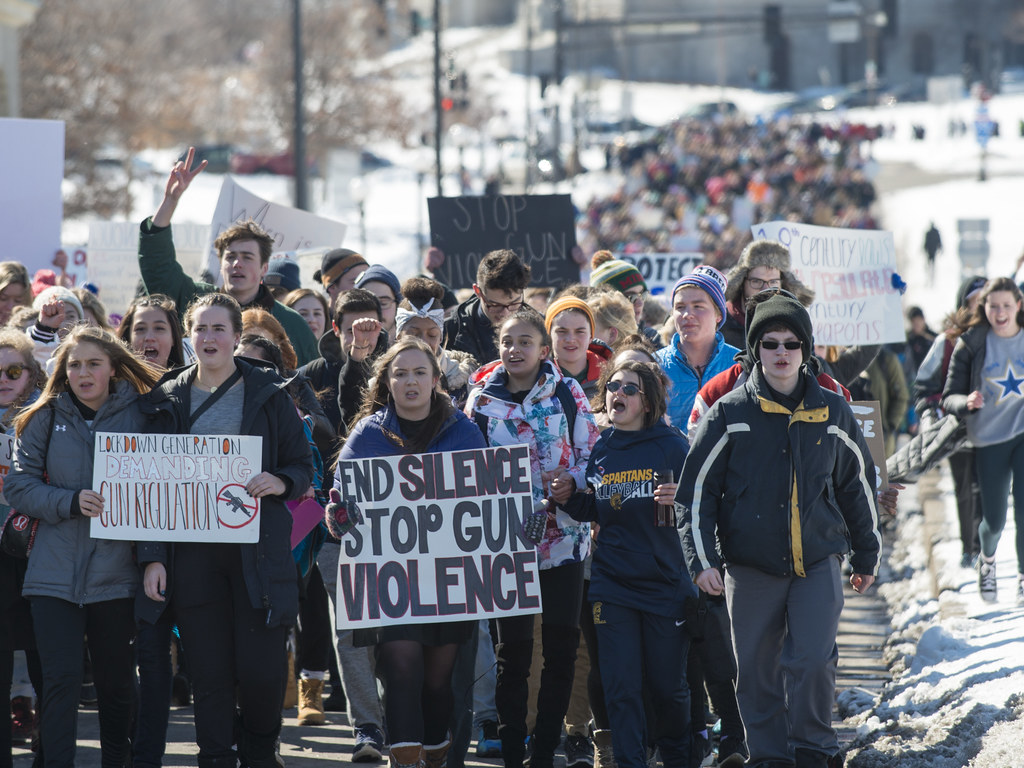“March For Our Lives student protest for gun control” by Fibonacci Blue is licensed under CC BY 2.0.
With a recent influx of gun violence in the news, many Americans express having trouble staying informed with every occurring tragedy. The nonprofit organization Everytown: For Gun Safety did a 12-year overview on mass shootings in the United States. “Between 2009 and 2020, 1,363 people in the United States were killed and 947 more were wounded in 240 mass shootings, an average of 20 shootings each year. Among the casualties were at least 362 children and teens killed as well as 21 law enforcement officers killed and 35 wounded.” Mass shootings have become an inescapable reality in American life. Everytown defines a mass shooting as any incident in which four or more people are shot and killed, excluding the shooter.
Although there is still debate on what specific numbers constitute a “mass shooting” in the news, many are trying to come up with general solutions to document gun violence. The New York Times writes, “the deadliest mass shooting in the country so far this year was the massacre in which 19 children and two teachers were killed at an elementary school in Uvalde, Texas, on May 24.” The Gun Violence Archive has listed at least 606 mass shootings so far in 2022 as of November. On Thanksgiving eve, a drive-by shooting left four teenagers wounded on their way out of high school. On Nov. 22, a Walmart store manager opened fire in a break room resulting in six workers’ deaths. On Nov. 20, five nightclub goers in Colorado Springs were killed, with 18 more injured. Nov. 13 brought the death of three University of Virginia football players. Those are just this past month’s records, with 603 shootings preceding them. The Gun Violence Archive recorded 692 mass shootings in 2021.
While mourning the deaths of those taken by gun violence, communities have also expressed mourning a loss of safety. Many Americans don’t consider schools, places of worship and safe havens for marginalized groups (like the LGBTQ+) community to be safe. Erik Bottcher, a member of the New York City Council, spoke in response to the Colorado Springs hate crimes saying, “You can draw a straight line to those murders from the hateful rhetoric and lies that have been spread about Drag Queen Story Hour or transgender and gender-nonconforming people, and the same people who are spreading these lies are offering thoughts and prayers on Twitter today…. and they know. They know that these bars and nightlife venues are sacred spaces for our communities.”
This past election, on Nov. 8, featured gun reform topics on ballots across the nation. The United States Constitution provides citizens with the right to bear arms, courtesy of the Second Amendment. The Pew Research Center conducted multiple surveys on the status of firearms with the following results: four out of 10 adults live in a home with a gun. “There are differences in gun ownership rates by political party affiliation, gender, geography and other factors. For instance, 44% of Republicans and Republican-leaning independents say they personally own a gun, compared with 20% of Democrats and Democratic leaners.” Men are more likely to own a gun, as opposed to women. The top reason gun owners provide is personal protection. Only 6% of Americans, when polled, stated that gun violence is not a problem. When looking at racial groups, about eight-in-ten Black adults (82%) say gun violence is a very big problem. In comparison to other groups, about 58% of Hispanic adults and 39% of white adults view gun violence this way.
In June 2022, President Joe Biden signed into law a landmark gun control bill. The reform includes tougher background checks for buyers under 21 years of age, federal funding for mental health programs and banning those convicted of domestic violence crimes from owning a gun. Passed with bipartisan support, the bill is a small step in the direction of gun reform for America.
Federal law bars citizens under the age of 21 from purchasing a handgun, however this does not include shotguns. The new federal gun law also adds juvenile and mental health records of buyers 18 to 20 years old to the FBI’s background check database. It also increases the length of time allowed for a youth background check to 10 days. Red flag laws, also known as Extreme Risk Protection Orders, allow police to temporarily seize legally owned guns from people who a judge has ruled to be a danger to themselves or others. Washington DC, along with 19 states, have enacted red flag laws. Many places of business and government offices are enforcing gun-free zones where firearms are banned. Some police departments have opted to try and buy back guns in efforts to have community members voluntarily submit their weapons.
When comparing the United States to various European countries, gun violence remains a top issue. Although the nation remains a leader in mass shootings, many Americans feel there are not enough efforts to reform this violence.
Emily Hart is a fourth-year English major. EH943163@wcupa.edu

